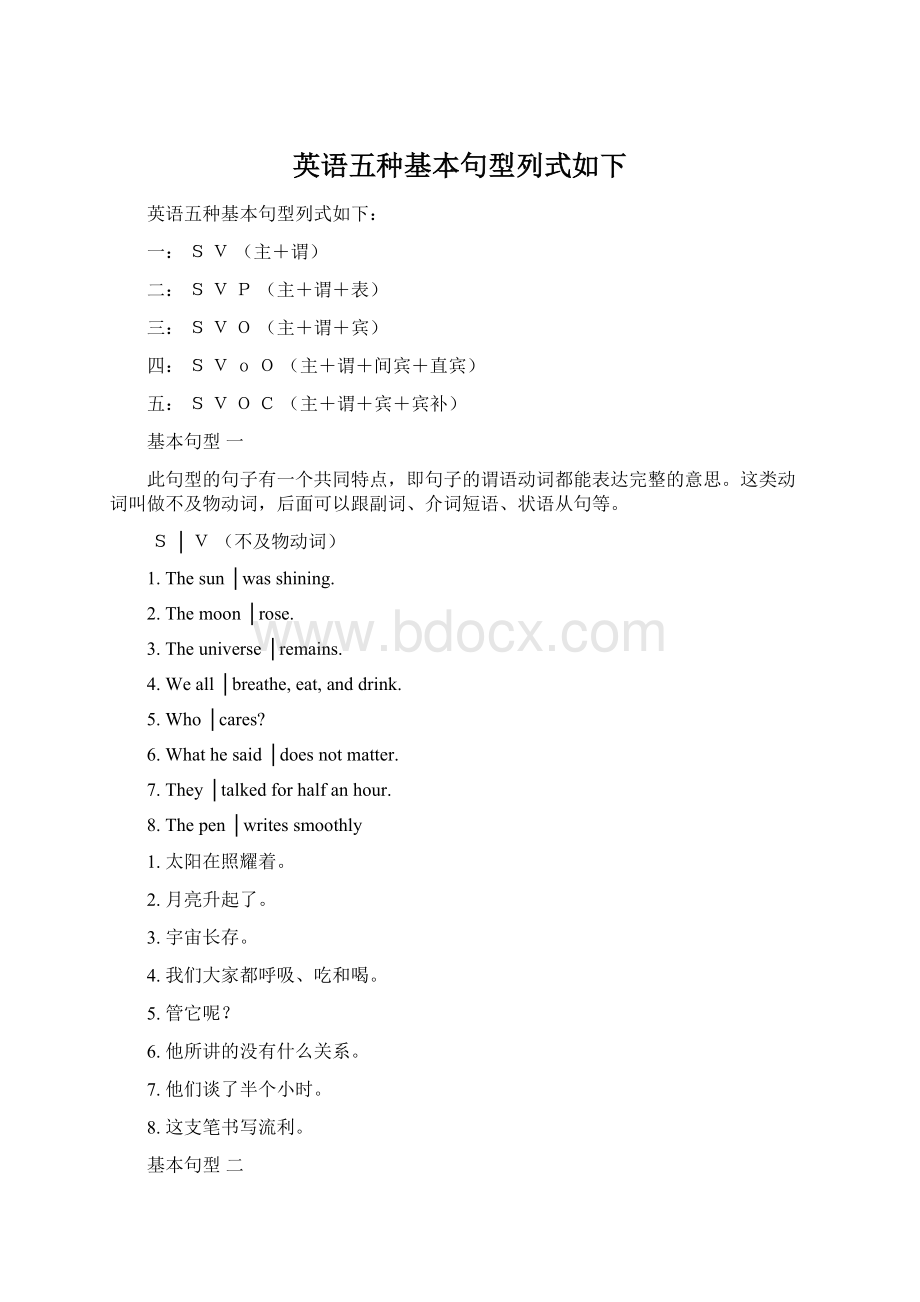英语五种基本句型列式如下.docx
《英语五种基本句型列式如下.docx》由会员分享,可在线阅读,更多相关《英语五种基本句型列式如下.docx(9页珍藏版)》请在冰豆网上搜索。

英语五种基本句型列式如下
英语五种基本句型列式如下:
一:
SV(主+谓)
二:
SVP(主+谓+表)
三:
SVO(主+谓+宾)
四:
SVoO(主+谓+间宾+直宾)
五:
SVOC(主+谓+宾+宾补)
基本句型一
此句型的句子有一个共同特点,即句子的谓语动词都能表达完整的意思。
这类动词叫做不及物动词,后面可以跟副词、介词短语、状语从句等。
S│V(不及物动词)
1.Thesun│wasshining.
2.Themoon│rose.
3.Theuniverse│remains.
4.Weall│breathe,eat,anddrink.
5.Who│cares?
6.Whathesaid│doesnotmatter.
7.They│talkedforhalfanhour.
8.Thepen│writessmoothly
1.太阳在照耀着。
2.月亮升起了。
3.宇宙长存。
4.我们大家都呼吸、吃和喝。
5.管它呢?
6.他所讲的没有什么关系。
7.他们谈了半个小时。
8.这支笔书写流利。
基本句型二
此句型的句子有一个共同的特点:
句子谓语动词都不能表达一个完整的意思,必须加上一个表明主语身份或状态的表语构成复合谓语,才能表达完整的意思。
这类动词叫做连系动词。
系动词分两类:
be,look,keep,seem等属一类,表示情况;get,grow,become,turn等属另一类,表示变化。
be本身没有什么意义,只起连系主语和表语的作用。
其它系动词仍保持其部分词义。
S│V(是系动词)│P
1.This│is│anEnglish-Chinesedictionary.
2.Thedinner│smells│good.
3.He│fell│inlove.
4.Everything│looks│different.
5.He│isgrowing│tallandstrong.
6.Thetrouble│is│thattheyareshortofmoney.
7.Ourwell│hasgone│dry.
8.Hisface│turned│red.
1.这是本英汉辞典。
2.午餐的气味很好。
3.他堕入了情网。
4.一切看来都不同了。
5.他长得又高又壮。
6.麻烦的是他们缺少钱。
7.我们井干枯了。
8.他的脸红了。
基本句型三
此句型句子的共同特点是:
谓语动词都具有实义,都是主语产生的动作,但不能表达完整的意思,必须跟有一个宾语,即动作的承受者,才能使意思完整。
这类动词叫做及物动词。
S│V(及物动词)│O
1.Who│knows│theanswer?
2.She│smiled│herthanks.
3.He│hasrefused│tohelpthem.
4.He│enjoys│reading.
5.They│ate│whatwasleftover.
6.He│said│"Goodmorning."
7.I│want│tohaveacupoftea.
8.He│admits│thathewasmistaken.
1.谁知道答案?
2.她微笑表示感谢。
3.他拒绝帮他们。
4.他喜欢看书。
5.他们吃了剩饭。
6.他说:
"早上好!
"
7.我想喝杯茶。
8.他承认犯了错误。
基本句型四
此句型的句子有一个共同特点:
谓语动词必须跟有两个宾语才能表达完整的意思。
这两个宾语一个是动作的直接承受者,另一个是动作的间接承受者。
通常这一间接承受者用一个介词来连接,当动作的间接承受者在动作的直接承受者之前时,这一介词被省略。
S│V(及物)│o(多指人)│O(多指物)
1.She│ordered│herself│anewdress.
2.She│cooked│herhusband│adeliciousmeal.
3.He│brought│you│adictionary.
4.He│denies│her│nothing.
5.I│showed│him│mypictures.
6.I│gave│mycar│awash.
7.I│told│him│thatthebuswaslate.
8.He│showed│me│howtorunthemachine.
1.她给自己定了一套新衣裳。
2.她给丈夫煮了一顿美餐。
3.他给你带来了一本字典。
4.他对她什么都不拒绝。
5.我给他看我的照片。
6.我洗了我的汽车。
7.我告诉他汽车晚点了。
8.他教我开机器。
基本句型五
此句型的句子的共同特点是:
动词虽然是及物动词,但是只跟一个宾语还不能表达完整的意思,必须加上一个补充成分来补足宾语,才能使意思完整。
S│V(及物)│O(宾语)│C(宾补)
1.They│appointed│him│manager.
2.They│painted│thedoor│green.
3.This│set│them│thinking.
4.They│found│thehouse│deserted.
5.What│makes│him│thinkso?
6.We│saw│him│out.
7.He│asked│me│tocomebacksoon.
8.I│saw│them│gettingonthebus.
1.他们任命他当经理。
2.他们把门漆成绿色。
3.这使得他们要细想一想。
4.他们发现那房子无人居住。
5.他怎么会这样想?
6.我们送他出去。
7.他要我早点回来。
8.我看见他们上了那辆公共汽车。
但常用的英语句子并不都象基本句型这样简短,这些句子除了基本句型的成分不变外,通常是在这些成分的前面或后面增加一些修饰语(modifier)而加以扩大。
这些修饰语可以是单词(主要是形容词、副词和数词),也可以是
各种类型的短语(主要是介词短语、不定式短语和分词短语)。
下面以基本句型五为例:
Wefoundthehallfull.
我们发现礼堂坐满了。
Wefoundthegreathallfullofstudentsandteachers.
我们发现大礼堂坐满了学生和教师。
Wefoundthegreathallfullofstudentsandteacherslisteningtoanimportantreport.
我们发现大礼堂坐满了学生和教师,在听一个重要报告。
WefoundthegreathallfullofstudentsandteacherslisteningtoanimportantreportmadebyacomradefromthePeople'sDailyoncurrentaffairsinEastEurope.
我们发现大礼堂坐满了学生和教师,在听人民日报的一位同志作有关东欧局势的重要报告。
不同的动词使用的句型也不尽一样,因此在学习动词时,应掌握动词的类型。
从句的类型
•定语从句
•状语从句
•主语从句
•宾语从句名词性从句
•表语从句
•同位语从句
定语从句的分类
•限制型定语从句(RestrictiveAttributiveClauses)
Amanwhodoesn’ttrytolearnfromotherscan’thopetoachievemuch.
•非限制性定语从句(Non-RestrictiveAttributiveClauses)
SheisgoingtospendthesummerholidaysinQingdao,whereshehassomerelatives.
定语从句的引导词
•关系代词(who,whom,which,that,as)
•关系副词(where,when,why,that)
•关系形容词(whose,what)
Hethatwouldeatthefruitmustclimbthetree.
ThatisthereasonwhyIaminfavorofrevisingtheplan.
Ihavethesametroubleasyoudo.
状语从句的种类
•时间状语从句
•地点状语从句
•原因状语从句
•目的状语从句
•结果状语从句
•条件状语从句
•让步状语从句
•比较状语从句
•方式状语从句
状语从句的引导词
(1)
•时间(when,as,while,before,after,once,till,until,notuntil,eversince,since,whenever,every/eachtime,themoment,assoonas,nosooner...than,scarcely/hardly…before/when,nowthat)
•地点(where,wherever)
•原因(because,as,since,nowthat,seeingthat,consideringthat,inthat)
状语从句的引导词
(2)
•目的(that,sothat,inorderthat,lest,forfearthat,incase)
•结果(that,sothat,so…that,such…that)
•条件(if,unless,onlyif,once,suppose,supposing,incasethat,solongas,aslongas,sofaras,onconditionthat,providedthat,intheeventthat,whetherornot)
状语从句的引导词(3)
•让步(though,although,as,while,whereas,evenif,eventhough,nomatter,whatever,however,inspiteofthefactthat)
•比较(as…as,notso/as…as,more…than,nomore…than,less…than,noless…than,the…the...)
•方式(asthough,asif,justas…,so…)
状语从句示例
(1)
•HehadimpressedmethefirsttimeImethim.
•WhereverIamIwillbethinkingofyou.
•Consideringthattheyarejustbeginners,theyaredoingquiteagoodjob.
•Bettertakemoreclothesincasetheweatheriscold.
•Bringitnear(so)thatImayseeitbetter.
状语从句示例
(2)
•ShewouldhavefallenbutthatIcaughther.
•YouarealittleheavierthanwhenIsawyoulast.
•Irememberthewholethingasifithappenedyesterday.
主语从句
•由what,whatever,whoever等代词引导的主语从句
•由连词that引导的主语从句(通常放到句子后部,而用it作形式主语,在口语中that有时可省略)
•由连接代词或连接副词(或whether)引导的主语从句(可直接放句首,也可放句子后部,并在句首用it作形式主语)
主语从句
•Whatyouneedismorepractice.
•WhateverIhaveisatyourservice.
•ItispossiblethatImaynotbeabletocome.
•It’sapityyoumissedsuchafinetalk.
•Whetherhewilljoinuswon’tmaketoomuchdifference.
•Hasitbeenannouncedwhentheplanesaretotakeoff?
宾语从句
•由连接代词或副词引导的宾语从句
•由关系代词what等引导的宾语从句
•由that引导的宾语从句(最为普遍,that有时可省略,另外在某些带有复合宾语的句子中,that引导的从句常常移到句子后部,前面用it作形式宾语)
宾语从句
•Tellmewhatyouwant.
•Let’sseehowwecanraiseourefficiency.
•PleaseadvisemewhichbookIshouldreadfirst.
•Whetherthatisagoodsolutiondependsonhowyoulookatit.
•We’llgiveyouwhateverhelpyouneed.
•Shewasneversatisfiedwithwhatshehadachieved.
•Idon’tdoubtthattheywillbeabletoovercomethedifficulties.
表语从句
•由that引导的表语从句(口语中连词that有时可以省略)
•由关系代词what引导的表语从句
•由连接代词或副词引导的表语从句
表语从句
•Thefactremainsthatwearebehindtheothergroups.
•Chinaisnolongerwhatitusedtobe.
•Thequestioniswhatweshoulddofirst.
•Myideaiswecangetmorepeopletohelpinthework.
同位语从句
•在某些词(如idea,fact,rumor,news,hope,belief,thought,doubt等)后有时可以用that或连接代(副)词引导的从句作同位语,称为同位语从句。
同位语从句
•Ihavenoideathatyouwerehere.
•Thefactthattheprisonerwasguiltywasplaintoeverybody.
•Thethoughtcametohimthatmaybetheenemyhadfledthecity.
•Obviouslytherewaslittleprobabilitythattheywouldsucceed.
练习
1.____Icatchacold,Ihavepaininmyback.
A.EverytimeB.If
C.UntilD.Atthetime
2.Somewaterissaidtobe“hard”.Bythisismeant____itdoesnotlatherreadilywithsoap.
A.whichB.asC.whatD.that
3.____heisabsent,whatshallwedo?
A.NowthatB.Seeingthat
C.SupposingthatD.Whether
4.Languagebuildsabridgeofcommunication____societycouldnoteverexist.
A.unlessB.withoutthat
C.withoutwhichD.Justas…so
5.Theproblemisthat,____childrenwhoaregivencow’smilkbenefitgreatlyfromit,thosewhohaveneverdrunkitbyacertainagearenotabletotolerateit.
A.becauseB.provided
C.whereasD.though
6.Justasthesoilisapartoftheearth,____theatmosphere.
A.asitisB.Thesameas
C.soisD.andsois
7.Thisresearchprojecthadmoresignificanceforthemthan____.
A.oursB.itdidforus
C.withusD.foroursithad
8.____youcannotmeetusasplanned,pleaseletusknowimmediately.
A.SuchthatB.Intheeventthat
C.AsifD.Inorderthat
9.____itisexpensiveornotisthecrucialquestion.
A.ThatB.WhetherC.IfD.How
ADACDCBBB